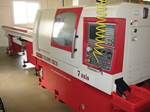How to Choose the Right CNC Router
With moldmaking the focus is on injection molding or other mold types that use wire EDM or CNC machining centers to create the mold components. Your typical machining center weighs several tons and has a relatively small working envelope compared to a CNC router. The mill’s massive construction lends itself to machining rigid materials with very tight tolerances. While this type of CNC is suited for injection molding components, it isn’t always the ideal tool for the job when we broaden our scope of moldmaking and the current opportunities in the marketplace
The first thing about a CNC router that really stands out from a CNC mill is the scale. A CNC router can have a machinable area of 60" X 216" X 8". While the CNC router is not suited for cutting ferrous materials, it excels at cutting composite prototyping boards, plastics, carbon fiber and even non-ferrous metals with the proper accessories.
A CNC router can allow you to do larger scale mold masters and cavities, and in turn, service markets currently being ignored by most mold and pattern shops. Applications have included mold masters for 1/5 scale RC helicopter FRP molds, 6' x 10' centerboard masters for sailboats, antique grille masters for sand casting and various automotive application molds and masters for vacuum forming. The versatility of a CNC router is amazing as it excels at cutting smaller molds and masters with reliable tolerances in the .003 to .006" range.
With the addition of quality CAD/CAM software, small and start-up shops can create a viable operation with the combination of thermoforming equipment and a CNC router. The CNC machines the appropriate plug or cavity, which is then sent to the thermoforming machine. The thermoformed part is then returned to the CNC and placed in a vacuum fixture or frame to hold the part. The CNC then accurately trims the circumference of the part, in addition to machining or drilling features necessary on the finished part.
This versatility allows smaller shops to be competitive with a minimal investment. Existing shops can use their CNC router to expand their business by catering to larger scale components for the thermoforming, FRP, sand casting, and even prototyping markets. The CNC router also can be used to create fixtures, packaging and a host of other parts to be used in the shop itself.
When choosing a CNC router for your business, the overall build quality of the machine is only one aspect to consider. Many CNC routers quickly become obsolete with costly upgrade paths or expensive replacement parts as the years begin to take their toll on the machine. Do your research, visit local shops that have the brand of router you are interested in and ask lots of questions.
Does the CNC company’s website offer a user forum? How long have they been in business? Do they take the time to really listen to what my needs are? What’s the warranty on the machine and how much will I be charged if I need technical support?
These are just a few questions you should be asking before purchasing a CNC router for your small- to medium-sized moldmaking operation. The focus of your quest should be getting the most value for your hard-earned dollar.
Related Content
-
Revisiting Some Hot Runner Fundamentals
What exactly does a hot runner do? If you’ve been in the injection molding industry for any length of time, you might think the answer is obvious, but it is not.
-
Advantages and Disadvantages of Copper and Graphite Electrodes
Both copper and graphite provide approximately the same end result, so it is important for a shop to consider the advantages and disadvantages of each material in order to discover what would work best in their shop floor environment.
-
The Benefits of Hand Scraping
Accuracy and flatness are two benefits of hand scraping that help improve machine loop stiffness, workpiece surface finish and component geometry.















